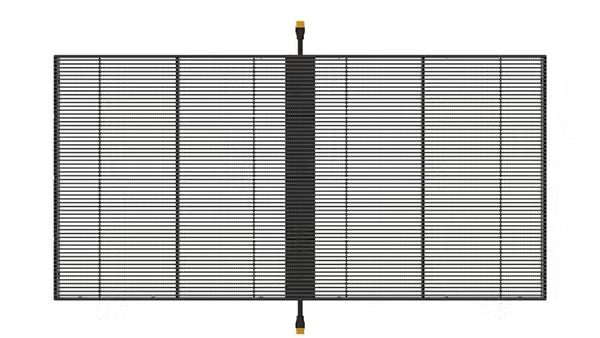
The transparent LED screen stands as one of the remarkable innovations of the 21st century. As a highly effective and cost-efficient method to incorporate digital content into various environments, these screens create a more immersive and engaging experience. But what exactly are they? What functions do they serve? How do they operate? This article aims to answer these queries and highlight some real-world applications visible in local shopping centers and even on personal devices like smartphones and tablets. Keep reading!
What is a Transparent LED Screen?
A transparent LED screen represents an advanced flat-panel display technology that resembles a clear material like glass while integrating LED capabilities. These screens find their application across diverse venues, including amusement parks, shopping malls, educational institutions, and conference centers, delivering impressive visual experiences. Compared to conventional liquid crystal displays (LCDs), transparent LED screens offer numerous advantages, particularly in cost-effectiveness and energy efficiency, thanks to their lower power consumption. They also provide rapid data transmission, achieving ultra-high definition and high brightness due to their use of full-color pixel technology, where each pixel comprises red, green, and blue sub-pixels.
The most striking aspect of transparent LED screens is their ability to create a sense of proximity to the displayed images. This is due to the LED technology, which renders visuals much more lifelike than traditional LCDs. With a wide viewing angle of up to 180 degrees, users can share experiences seamlessly, enhancing their value in public spaces. Additionally, transparent displays do not rely on heavy optical components such as polarizers or filters, simplifying transportation and installation.
How Does a Transparent LED Display Work?
Current LCD, plasma, and OLED technologies typically consist of a layered structure with two panels bonded together by a liquid crystal substance sandwiched between transparent electrodes. While appearing clear, these displays do not achieve full transparency. In contrast, transparent LED displays operate on a different principle. They utilize light-emitting devices, such as organic LEDs (OLEDs) or standard LEDs.
These displays work by allowing light to pass through an array of LEDs or OLEDs, which can render the material opaque without needing an external power source. Essentially, the OLED and LED arrays absorb external backlighting and re-emit it, resulting in transparency when inactive, as there is no obstruction to the passage of light.
Applications of Transparent LED Screens
Transparent LED screens share similarities with their opaque counterparts, displaying messages and information while seamlessly integrating with their environment. Their versatility and cost-effectiveness make them suitable for a variety of applications. The same technology that benefits advertising can also be harnessed in consumer electronics such as smartphones, tablets, laptops, and TVs. Below are notable applications for transparent LED screens:
Outdoor Applications (Billboards)
Transparent screens are typically made from durable plastics like Polyethylene Terephthalate (PET) or Polycarbonate (PC), making them weather-resistant and suitable for outdoor use. Their discreet design allows for effective advertising without drawing excessive attention. Often positioned along busy roads, these screens can display a multitude of messages, from event promotions to product launches. They excel in high-traffic areas like bus stops and malls, where their subtle presence can capture passerby attention.Outdoor Applications (Building Facades)
Transparent LED screens enhance glass-walled buildings by providing visibility while maintaining security and privacy. This technology is beneficial not only in corporate offices but also in residential areas. Moreover, it aids in lighting enhancement, especially where artificial lighting creates shadows during nighttime. For taller structures, these displays can serve as eye-catching advertising spaces, showcasing company promotions or city events, effectively merging aesthetic appeal with functionality.Outdoor Applications (High-Rise Glass Walls)
In high-rise buildings, transparent LED screens function similarly to street billboards, positioned behind glass panels. This setup allows external visibility while keeping internal spaces open. Often used for advertising, these screens can display vibrant graphics to attract attention, offering branding opportunities for restaurants and entertainment venues. They can also showcase events, creating an inviting atmosphere while maintaining patrons’ privacy.Indoor Applications (Shopping Malls)
Transparent LED screens are effective within shopping malls, often placed at entrances to guide shoppers or inform them about available products. Their bright displays draw attention, enhancing the shopping experience. These screens can serve as dynamic advertising platforms, whether for short-term promotions or continuous video loops.Indoor Applications (Showrooms)
In showrooms, transparent LED screens can be positioned behind glass, allowing customers to view products without close contact. This transparency ensures that potential buyers can appreciate the items on display while protecting them from touch and environmental factors. Museums and galleries utilize similar technology to showcase exhibits, providing visibility while safeguarding the artifacts.Indoor Applications (Airports)
Transparent LED screens are invaluable in airports for wayfinding, guiding passengers to gates or amenities. They can communicate essential information about delays or updates, helping travelers make informed decisions. Additionally, these displays can be used for advertising, promoting products to waiting customers who have limited activities while waiting for their flights.Indoor Applications (Entertainment Venues)
Transparent LED screens find utility in clubs, restaurants, and smaller businesses such as nail salons. They can effectively advertise services and announce special events, enhancing the ambiance and capturing potential customers’ attention.
How to Choose a Transparent LED Display?
Selecting the right transparent LED display can feel daunting due to various factors to consider. Here are some guidelines to aid in your decision-making:
Protection Technology
Understanding the intended use of the display is crucial. While many transparent displays are designed for indoor settings, glare protection and brightness features become vital for outdoor applications. High levels of sunlight can impede readability, necessitating enhanced brightness.Brightness
Brightness is a critical factor in choosing a transparent display. Certain applications may demand higher brightness to remain legible in bright environments, while others might require dimming to mitigate glare.Resolution
The resolution of a display is another important consideration. A higher pixel count generally yields clearer images, but the transparent nature of these screens limits pixel density. Selecting an appropriate pixel quantity is essential to avoid uneven lighting or reduced efficiency.Ambient Light Management
Consider the level of ambient light exposure where the display will be situated. Implementing ambient light sensors (ALS) can optimize energy consumption by automatically adjusting the LED brightness according to environmental conditions.Heat Management Systems
Lastly, it’s important to evaluate the heat management features of the display, such as heat sinks and fans, to prevent overheating, especially since transparent displays are more susceptible to temperature fluctuations due to their exposure to light.
The Future of Transparent LED Technology
In summary, the transparent LED screen was once viewed as a far-fetched concept. However, after years of diligent research and development by scientists and engineers globally, we have entered a phase where groundbreaking technological advancements are commonplace. Each day brings new discoveries—from advanced computing solutions to groundbreaking medical innovations—that profoundly impact our lives. These technologies are set to shape our future in remarkable ways and open up exciting possibilities for those who seek them.

